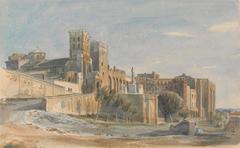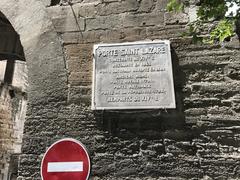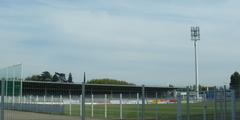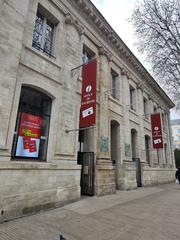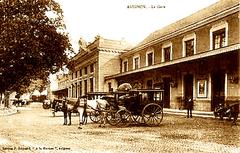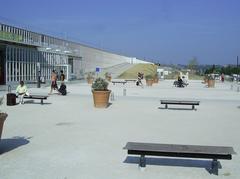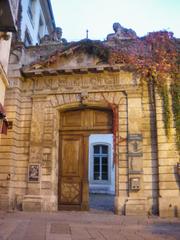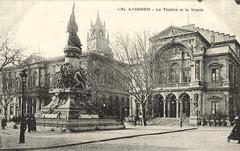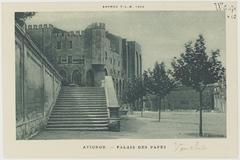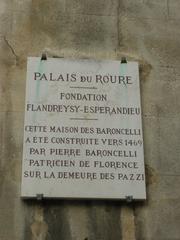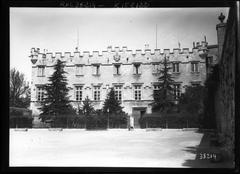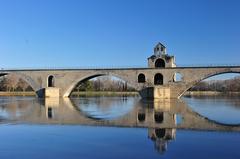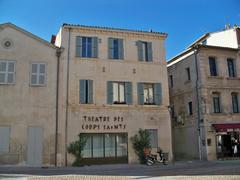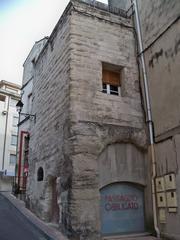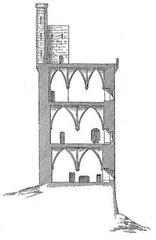Abbaye De Saint-Ruf d’Avignon: Visiting Hours, Tickets, and Historical Guide
Date: 04/07/2025
Introduction
Nestled in the historic city of Avignon, France, the Abbaye de Saint-Ruf d’Avignon stands as a compelling monument to the region’s rich medieval heritage. With origins tracing back to the early medieval period—possibly as early as the 4th century—this abbey has been pivotal in shaping Avignon’s religious, architectural, and cultural landscape. As the mother house of the Order of Saint-Ruf, the abbey significantly influenced the Gregorian Reform and helped shape religious practices across southern Europe. Today, its evocative ruins and tranquil gardens offer visitors a unique blend of spiritual history and architectural beauty.
This comprehensive guide presents key information on the abbey’s history, cultural impact, visitor tips, opening hours, ticketing, and accessibility. Whether you are a history enthusiast, architecture lover, or a traveler seeking Avignon’s hidden gems, this article will help you plan a memorable visit. For the latest updates, consult the official Avignon tourism website (Avignon Tourisme) and France-Voyage.
Table of Contents
- Introduction
- Historical Overview
- Architectural Features
- Cultural and Religious Significance
- Visitor Information
- Nearby Attractions and Travel Tips
- Frequently Asked Questions (FAQ)
- Further Reading and Resources
- Conclusion
Historical Overview
Early Origins and Foundation
The earliest reference to the Abbaye de Saint-Ruf d’Avignon appears in 917, in a precept by Emperor Louis the Blind, which cites a church dedicated to Saint Rufus outside Avignon’s walls. Some traditions and archaeological findings suggest Christian worship at the site as early as the 4th century (eglises-de-provence.fandom.com). The site’s continuous sacred use, built atop a paleo-Christian necropolis, underscores its longstanding spiritual importance (brilliant-tourism.com).
Growth and Ecclesiastical Influence
By the 11th century, the abbey was reorganized by clerics following the Rule of Saint Augustine. It rose to prominence thanks to papal support and noble patronage, notably from the counts of Barcelona. In 1084, Pope Gregory VII elevated it to abbey status, and Pope Urban II confirmed its holdings in 1092, marking it as a recognized center for the Gregorian Reform. The abbey’s customs and statutes were influential, shaping religious communities in France, Spain, and beyond.
The Order of Saint-Ruf
The abbey became the headquarters of the Canons Regular of Saint Ruf, a congregation known for its role in the reform of canonical life and dissemination of new liturgical practices. The order’s reach extended through the founding of over a hundred churches dedicated to Saint Ruf across southern France, Spain, Italy, and the Holy Land. Nicholas Breakspear, who served as abbot from 1143–1147, later became Pope Adrian IV—the only English pope in history.
Decline and Transformation
From the mid-12th century, the abbey’s influence waned, exacerbated by disputes with the Avignon cathedral chapter and the eventual transfer of the order’s headquarters to Valence in 1158. The site suffered during the French Wars of Religion and was largely abandoned by the 18th century. The French Revolution resulted in the confiscation and sale of the abbey’s remaining structures, many of which fell into ruin (France-Voyage).
Architectural Heritage
Classified as a Monument Historique since 1889, the abbey’s remains include the chevet, bell tower, transept, and parts of the nave, all set within landscaped gardens. These ruins, combining Romanesque solidity with early Gothic elements, provide a striking setting for historical reflection (Avignon Tourisme).
Architectural Features
Exterior and Layout
The abbey originally centered around a cloister, with the church as its spiritual heart. Surviving exterior walls of local limestone display weathered sculpted capitals and Romanesque portals. The traditional Benedictine layout, with the church on an east-west axis and monastic buildings around the cloister, is still discernible in the site’s foundations.
The Abbey Church: Romanesque and Gothic Elements
The church showcases robust Romanesque features: thick walls, barrel vaults, and semicircular arches. Later Gothic modifications are visible in pointed arches and ribbed vaulting. The apse, with its small, deep-set windows, creates a sense of intimacy, while traces of medieval frescoes and decorative stonework remain on the walls.
Cloister and Monastic Buildings
Although mostly lost, the cloister’s arcaded walkways and columns are partially reconstructed, hinting at the contemplative atmosphere that once prevailed. Ruins of the chapter house, refectory, and dormitory reflect the abbey’s original monastic functions and its Cistercian-inspired architectural austerity.
Decorative and Artistic Heritage
Decorated capitals with stylized foliage and geometric motifs, as well as fragments of frescoes and funerary monuments, attest to the abbey’s artistic and spiritual legacy. A marble capital depicting the Dream of Joseph, dated to around 1145, is a notable example and is housed in the Musée du Petit Palais in Avignon (eglises-de-provence.fandom.com).
Modern Integration
Post-Revolution, the abbey’s grounds were adapted for secular uses and are now integrated into Avignon’s urban landscape, with the surrounding park providing public access and recreation (Parc de l’Abbaye de Saint-Ruf). This adaptive reuse balances heritage conservation with contemporary community needs.
Cultural and Religious Significance
The abbey’s dedication to Saint Ruf, regarded as Avignon’s first bishop, linked local devotion to early Christian tradition, enhancing its status as a pilgrimage destination. The Canons Regular of Saint Ruf played a key role in the spread of the Gregorian Reform, influencing church practices across southern Europe and beyond. The abbey also hosted important ecclesiastical councils in the 14th century, cementing its reputation as a center for religious and political affairs.
The abbey’s fortified structures reflect its dual role as both sanctuary and refuge. Over the centuries, it served not only as a spiritual center but also as a community hub, providing religious services, education, and charity.
Today, the abbey’s ruins serve as a powerful reminder of Avignon’s dynamic medieval history and the enduring legacy of religious reform and artistic achievement (brilliant-tourism.com).
Visitor Information
Opening Hours and Tickets
- Opening Hours: The abbey grounds and gardens are open daily, typically from 9:00 AM to 6:00 PM (or until sunset in summer). Hours may vary; check the official Avignon tourism site for updates.
- Admission: Entry is free; no tickets are required. Voluntary donations for site preservation are welcome.
Accessibility
- The gardens and main pathways are fairly level and accessible, but some uneven terrain and ruins may pose challenges for visitors with mobility impairments. Contact the tourism office for specific details.
Guided Tours
- Guided tours are available via the Avignon tourism office. Audio guides can be downloaded for self-paced exploration. Special events and heritage days are occasionally hosted on-site (Abbaye Saint-Ruf).
On-Site Experience
- The abbey offers a peaceful retreat with landscaped gardens ideal for photography, picnics, and contemplation. Interpretive signage is limited, so advance research or a guide is recommended. There are no on-site cafés or restrooms; facilities are available in the city center.
Nearby Attractions and Travel Tips
While exploring the Abbaye de Saint-Ruf, consider visiting:
- Palais des Papes: Avignon’s iconic papal palace.
- Pont Saint-Bénézet: The famous “Pont d’Avignon.”
- Rocher des Doms Gardens: Panoramic views and lush landscaping.
Getting There: The abbey is easily accessible by foot, bicycle, or public transport. The nearest tram stop is Jouveau; bike rentals are available at Place Saint-Ruf. On-site parking is limited but available nearby.
Seasonal Tips: Spring and early autumn offer the best weather and garden blooms. Early mornings or late afternoons provide ideal lighting for photography and a quieter atmosphere.
Frequently Asked Questions (FAQ)
Q: What are the opening hours?
A: The site is typically open daily from 9:00 AM to 6:00 PM, or until sunset.
Q: Is there an entrance fee?
A: No, admission is free.
Q: Are guided tours available?
A: Yes, through the Avignon tourism office; audio guides are also available.
Q: Is the abbey accessible for visitors with disabilities?
A: Some paths are accessible, but uneven terrain may pose challenges.
Q: Are there restrooms or cafés on site?
A: No; facilities are available in nearby neighborhoods and the city center.
Further Reading and Resources
- Official Avignon Tourism Site
- Abbaye de Saint-Ruf on France-Voyage
- Abbaye Saint-Ruf: Description and Photos – Brilliant Tourism
- Abbaye Saint-Ruf Historical Data – Églises de Provence Wiki
- Parc de l’Abbaye de Saint-Ruf
Conclusion
The Abbaye de Saint-Ruf d’Avignon endures as a vital testament to Avignon’s medieval past, ecclesiastical reform, and artistic tradition. Free to visit and nestled in tranquil gardens, it invites reflection and discovery while complementing Avignon’s other historical attractions. Plan your visit to experience the layered history and serene ambiance of this remarkable site.
For more information, download the Audiala app for audio guides, explore related articles, and follow us on social media for the latest updates on Avignon’s historical treasures.
Sources
- This article draws information from the following resources:

